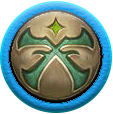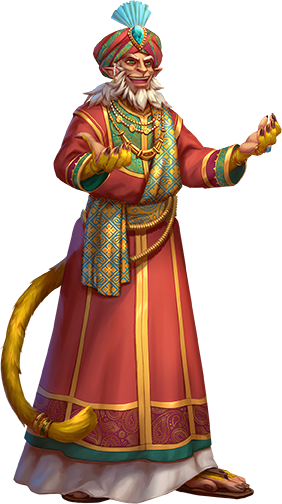
VanaraLegacy Content

 Uncommon Humanoid Vanara Source Impossible Lands pg. 53Vanaras are inquisitive and mischievous monkey-like humanoids with short, soft fur, expressive eyes, and long, prehensile tails. Their handlike feet and agile builds serve them well in the jungle realms where most vanaras live.
Uncommon Humanoid Vanara Source Impossible Lands pg. 53Vanaras are inquisitive and mischievous monkey-like humanoids with short, soft fur, expressive eyes, and long, prehensile tails. Their handlike feet and agile builds serve them well in the jungle realms where most vanaras live.Vanaras were born of the monkey god
Ragdya's ambitious folly ages ago, to spread and applaud his mischief and to serve as ba-sadhak, blessed seekers of fortune who would draw their creator's eye to the cruelly hoarded treasure of mortal lords and immortal fiends. They earned the enmity of ancient rakshasa maharajahs for their derring-do, the scorn of the naga empire for their valor, and the friendship of many rural Vudrani who viewed them as a wild folk of deep divine portent. Such is the history of vanaras and their long survival against their many foes, from within the mahajanapadas of the deep jungle lands, the mountain ghats of Vudra, and the Impossible Lands.
If you want to play a character who embodies the struggle between self-betterment and self-expression, you should play a vanara.
You Might...
- Find it difficult to avoid pursuing a mystery or exploring a hidden area.
- Thoughtfully consider the consequences of your pranks or actions.
- Enjoy sharing the knowledge of things you've discovered with your friends.
Others Probably...
- Assume you have an animalistic demeanor and habits.
- Take a dismissive or hostile view of your pranks.
- Covet your easy grace and unquenchable curiosity.
Physical Description
Vanaras are humanoids with simian features, including a long, prehensile tail and handlike feet. They're rarely much taller than 5 feet, but they usually look smaller because of their slight, nimble builds. Vanaras are covered with a thin layer of soft fur over their entire bodies. This fur can be tan, brown, or golden and rarely has spots or stripes. The hair on a vanara's head grows thicker and more luxurious; it's easy to arrange into elaborate hairstyles, and many vanaras like to do so. This hair is nearly always of the same color as the vanara's body fur, with the exception of rare “whitecape” vanaras with manes of fine, pale hair, who might be born into any vanara family. Vanaras have large, expressive eyes and mouths with blunt teeth and pointed incisors. Vanaras are adults at 13 years old and usually live about 60 years.
Society
Vanaras are a varied folk who seek balance and comfort in their lives. Many are devout without being fanatics, tricksters without being malicious, daring without being foolish, and curious without being obsessive. Although aware of their deep ancestral connection to Ragdya, many vanaras feel a powerful desire to live beyond the grace of their god and his weight in their history, pursuing their own paths to enlightenment. Those vanaras who live in Vudra feel this need the most strongly, as they want to pursue virtue and self-knowledge to be fulfilled when their souls are next reborn into the world.
Although created by Ragdya, vanaras feel themselves apart from him in a way some find uncomfortable. Ragdya is the eternal trickster with supreme recklessness yet unchanging in his immortal permanence. Though most vanaras cherish Ragdya's mischief and feats of folly on religious holidays, they also know he shall never fade from this world or find himself reincarnated into forms other than that from which the vanaras were shaped. Yet, vanaras aren't so immutable. A vanara must reflect on their own impermanent nature and consider its effect on their soul and their soul's quest for enlightenment. For all the mischief and daring Ragdya might enjoy without consequence, vanaras know recklessness and harmful tricks can impede their personal pursuit of enlightenment. The drive toward mischief and spontaneity instilled within them by their creator is hard for many vanaras to overcome and can create a lifetime of internal turmoil. This source of conflict has colored their development as a people who seek balance and virtue.
Vanaras look to the legends of heroic vanaras of the past for lessons on how to live their lives. The most notable and lauded accomplishment of these legendary vanaras, that which has them known even in the most far-flung ashram in the snow-capped border mountains of Vudra, was their grand act of trickery against Ravana, the greatest of all the
rakshasa immortals. Ravana had tyrannically forced many noble souls, vanara and human alike, to construct a resplendent bridge of azure stones that would cross the planes from Vudra to the rakshasa's realm. Ravana demanded that each stone be carved to display a mewling visage of the mortal who toiled to cut and shape it. Through mischief and artifice, vanaras altered the carvings so that, when assembled, they subtly displayed components of a prayer to all the Vudrani pantheon. When the bridge was finally finished and Ravana marched across it with his army of fiends in a profligate parade, the shuddering of the stones beneath their footsteps mimicked the movements of the communal prayer. Deities drawn by this display toppled the immortal maharajah, and he still blames mischief-making vanaras for this humiliation. Many vanaras thus see it as their legacy to bring shame to the wicked and powerful by means of clever tricks and communal effort.
Beliefs
Vanaras are tricksters who love pranks, but they temper this tendency toward mischief with good intentions and a love of their community—however they personally define that community. They're rarely agitators or troublemakers simply for the sake of causing chaos; they do so to encourage humility among the inflexible or humorless. Most vanaras are mindful of the virtues necessary to elevate their immortal souls and try to act accordingly. Vanaras are thus most likely to be neutral good.
Most vanaras live in Vudra, where they're exposed to the dizzyingly abundant array of Vudran deities. Nevertheless, devout vanaras nearly always venerate
Ragdya above all others. Priests of Ragdya lead most vanara villages. Even vanaras who aren't religious might call upon Ragdya to help them make wise decisions in times of danger or for guidance when an unlucky prank has caused them trouble they're unsure how to escape. Vanaras interested in developing self-control might worship
Irori instead, and regions with local vanara hero-gods or avatars might engender faithful sects of worshippers on a small scale. Some vanaras revere the evil simian hunter
Lahkgya, but almost never openly, as this deity of ferocious and sudden violence is unwelcome in most vanara communities. Some communities instead make offerings to turn Lahkgya's attention from them.
Adventurers
Vanara society, and its complex relationship with Ragdya, produces many adventurers who journey in search of greater insight into their nature of being and into other means that might provide them peace and enlightenment. Nearly all children are raised on the many embellished tales of their ancestors, vanara folk heroes, and their progenitor deity, and they emulate those stories as soon as they can. Thus, many vanaras have a background that evokes a colorful life prior to adventuring, such as
criminal,
entertainer,
gambler,
sailor, or
scout.
Vanaras found afield are often
champions,
rangers, or
rogues, but vanaras of every class view themselves as aligning with their beliefs, often with a special focus on their relationship with Ragdya and other gods. Vanaras who rely upon magic often find themselves serving as
witches under the patronage of distant karmic entities or ancient spiritual allies to the gods, or
oracles with unusual curses and mysteries.
Names
Newborn vanaras aren't given names other than descriptors of their infant personalities or habits, like “Grip-Hand” or “Wailer.” When they learn to speak, vanaras are given another name based on important historical or mythological figures, or they're given the name of a specific ancestor they resemble in appearance or attitude (or whom their community hopes they'll grow to resemble). The chosen name usually contains consonants or vowels the young vanara frequently uses, as vanaras don't see a lot of use in giving someone a name they can't easily pronounce.
Sample Names
Ashpaka, Chichipi, Haangeno, Hasa, Huanu, Kana, Nammem, Roprutu, Thathona, Unulu, Vivatu
Other Information
Natural Explorers
Vanaras might be found anywhere throughout the Impossible Lands. Those who seek discipline and greater insight into the arcane mysteries of existence have been known to gather within Nex's city of Quantium, where they trade knowledge of fiends and ancient koans as easily as others trade coins. Vanaras are a known, albeit quite unusual, sight within the metropolis of Absalom. From there, a vanara's journey to find enlightenment and self-knowledge—or to escape the relentless cycles of their past—might take them anywhere in the world.
Vanara Enclaves
Outside Vudra, where their numbers are plentiful and their presence relatively high, vanaras are typically seen only in the city of Niswan in Jalmeray, where they dwell as any other citizen under the thakur's influence. They've accompanied various Vudrani settlers to coastal settlements and communities in deep jungles or forests.
Vanara Mechanics
Hit Points
6
Size
Medium
Speed
25 feet
Attribute Boosts
Dexterity
Free
Languages
CommonVanaraAdditional languages equal to your Intelligence modifier (if it's positive). Choose from
Elven,
Gnome,
Infernal,
Goblin,
Sylvan, and any other languages to which you have access (such as the languages prevalent in your region).
Prehensile Tail
You can use your long, flexible tail to perform Interact actions requiring a free hand, even if both hands are otherwise occupied. Your tail can't perform actions that require fingers or significant manual dexterity, including any action that would require a check to accomplish, and you can't use it to hold items.